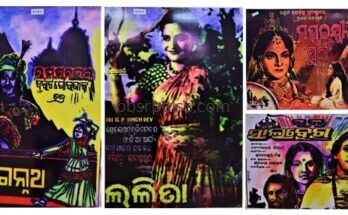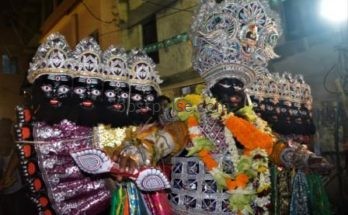Puri has been a pilgrimage centre for ages for all Hindus & there are many festivities & rituals surrounding Jagannath Temple. Puri was attacked at least 17 times, mostly by invaders (Jabanas) during non-Hindu rule in India. Jaga Ghara (servitors’ martial art training centre) as an institution was created by the Kings for the security of the pilgrims visiting Puri for darshan in general and Jagannath Temple & the triad’s safety in particular. During non-aggression time, the warriors entertain themselves by practicing/enacting various characters under Sahi Jata street festival. Here, Jaga Ghara plays a pivotal role in keeping alive the colourful festival of Sahi Jata.

Terms Associated with Jaga Ghara:
Under Sahi, there are Akhadas & under Akhadas there are various Jaga, Kota (କୋଟ) & Gada (ଗଡ). A Kota/Kote (same in Southern languages) or Gada means fort & there are various places with such suffixes like Khallikote & Jaugada for example. Same goes for the warfare training centres in Puri with suffixes as Gada or Kota/Kote. Originally, there were 16 Kota, 15 Gada & 38 Jaga, making it total as 69 under the 7 prominent Sahis entrusted with the security of Sri Mandir.A Sahi can have multiple Jaga Gharas, but affiliated to a single Akhada of the Sahi. Most of the Sahis especially surrounding Sri Mandir, have at least one permanent Jaga Ghara, set up by the erstwhile Kings of Odisha. And, some affluent zamindars have also donated Jaga (plot) for the same purpose. Jaga Gharas are quite spacious complex with huge trees, temple, tank with space for traditional mud wrestling & modern gymnasium. Only male members are part of Jaga Ghara culture & any related trainings. Every Jaga Ghara has its own Mahabir Temple & a Sahi Thakurani Temple. Mahabir epitomizes physical strength and celibacy whereas Sahi Thakurani Temple as their presiding deity. Tanks are used for temple rituals, bathing after training & most importantly swimming to attack/escape through waterways. The term ‘Jaga’ maybe derived from term Jagara (staying awake). The term Guruja (also Buruja) used in Jaga Ghara means half circle wall with holes used in four directions where cannons are kept like a fort (eg Ganesh Guruja). The gurus of Jaga Gharas are highly respected for their experience & knowledge pertaining to Jaga Ghara. They carries the duty to train the sebayat (servitor) members of their locality with various trainings like mud wrestling, acrobatics, malkham, mudgara, rope climbing, sword, stick & other weapons handling.

Jaga Ghara can be said to be the cultural centre for the people of Puri since music (mardala), dance (Odissi & Gotipua), recital (Odissi classical) are all carried out in a Jaga Ghara to keep the members in good mood. Someone had rightly said that Jaga Gharas are centres where Janga (practice physical exercise together), Sanga (friends), Bhanga (taking hemp together), Pangata (feasting together), Sangeeta (music) are all found in one place. Each Jaga Ghara & Sahi have their distinct insignia, flag & each Sahi is assigned different episode to enact under Sahi Jata. Onlookers can recognize the Jaga Ghara team on seeing the insignia & flags during Sahi Jata procession. The Jaga Ghara which is entitled to pilot the procession is known as Nishani Jaga. The current prominent Jaga Ghara are Gandamala Jaga (Kalika Debi Sahi), Bhoga Jaga (Mati Mandapa Sahi), Barabati Jaga , Jamei & Bada Akhada Jaga (Hara Chandi Sahi), Sata Bakhara & Paanda Jaga (Markandeswar Sahi), Sundaraa, Bisuni & Marichi Kota (Kundhaibenta Sahi), Jadu Tiadi & Champagada Jaga (Dola Mandap Sahi), Khuntia Jaga, Hinjalagada, Luhagada, Panchayat Jaga (Bali Sahi), Addanga Tiadi Jaga & Dhipa Jaga (Goudabada Sahi) etc.
The Other Characters Under Sahi Jata
The main characters of Sahi Jata, namely Rabana , Parashurama & Naga were posted in another blog (click on the link below to view it) & the rest are posted here.

Naga :- The Nagas are the most eye-catching characters of Sahi Jata with easily distinguishable round eyes, sharp nose & curly moustache with beard. In Sahi Jata, there are senior Nagas with tall muscular figures with prominent chest & junior Nagas with cute looks. Naga saja (decoration) is quite important & carried out as per Odra warrior. The music & musical instruments played during Naga Nacha is of strong Odra tradition too. The music accompanying Naga is of typical Odra style & Naga’s get up is like a Odra warrior & is seen wearing a loin cloth with a tiger skin & a taati (wooden frame) on his back with flags & is recognized by the lotus type hanging atop his heavy headgear. It’s said that earlier, the lotus & headgear had silver & expensive ornaments which now has been discontinued. He carries weapons like shield, knife, dagger, spear, trident, gun powder & a gun (recent addition, maybe during British Raj). Nagas are said to have links with the Naga sadhus of North India who are known to be quite fierce in defending the Hindu temples. In past, they have laid down their lives to protect the sanctity of Sri Mandir from the invaders. One among the 32 beshas (round the year attires) of Jagannath, is dedicated to these Nagas & named Nagarjuna Besha in which the Lord is seen sporting the taati in Kartika month. As a mark of respect to their valour, the Naga character has been incorporated in Sahi Jata & Gosani Jatra too which is another popular festival of Puri during Durga Puja time.

Meddha:- Meddha is like a mask dance form, added only to glorify the Sahi Jata. In order to amplify the characters, props like mukha (masks), bhuja (shoulder) & peti (belt) are added. The main characters like Rabana & Parashurama can’t move n touch all the bylanes during Sahi Jata. Moreover, the artist needs rest & refreshment in between acts under humid climate, that’s where the need of Medha arises to fill the gap & keep entertaining the spectators. The Meddha character moves in rhythmic procession to a specified Sahi as Baadi (ବାଦି) Sahi or Pratipakhya Sahi (competitive street). For eg. Bali Sahi is the Baadi Sahi of Harachandi Sahi & vice versa. Medhas move around the main characters during Sahi Jata & keeps the spirits high of the masses cheering up the characters with rhythmic Hey-Hey & Hari Bolo sound. The dance form here is called Meddha Nacha in which the young men use the mask of different puranic deities. While some artists applies makeup and dance/enacts different leelas, some still prefer using the masks which has been there since its inception. All the rest characters beyond Parashurama, Rabana etc can be termed as Meddha who are basically the support characters. They include Phula Medha, Nila Kali, Krushna Kali, Makaradhwaja (son of Hanuman), Shiba Tandaba Medha, Ardhanariswar Medha, Nrusingha Medha, Durga Medha, Kali, Bhadrakali, Panchamukhi Ganesha, Panchamukhi Hanuman etc. Then there are Sataras (linked with Guru Nanak’s troupe), Sabara Sabaruni (tribal couple), Sapua Sapuani (snake charmer couple) & other characters too. The major characters under Sahi Jata goes for rigorous training for at least month at their respective Jaga Gharas.

Apart from participating in Sahi Jata, the Jaga Ghara members also participate during Chandan Jatra, Krushna Leela, Sitala Sasthi etc with the Sahi Jata characters. Despite it, both the domestic and international tourists are unaware of the existence of Jaga Gharas & its culture. Tourists are more interested in visiting Jagannath Temple & spend leisure time by the sea beach or move out to nearby exotic locations. They prefer staying at beach facing hotels & thereby miss a vital tourist attraction of Jaga Gharas of Puri which is concentrated in the seven Sahis surrounding Sri Mandir. Moreover, there are certain inhibitions among the locals associated with Jaga Gharas. It’s a common perception that Jaga Ghara is strictly for males, thereby restricting women from visiting it as spectators. Further, bhaang culture has put a negative impression on the common people on the Jaga Ghara members. Again, Sahi Jata festival is mainly during the night hour which keeps away females from the street & they prefer to watch the events from the safety of their balconies. If the district administration takes care of the law & order of Puri during Sahi Jata, it will surely bring good ambience for all & make it into tourism circuit.

My sincere thanks to the Jaga Ghara members, sebayats & locals of Puri Town for their support & guidance.
Ref: Puri ra Sahi Jatra by Dr Surendra Mishra
Photos: Taranisen Pattnaik, Sketch: Sibasankar Das
©2020 All Rights Reserved. info@bbsrpulse.com





Wonderful write up, Lot of insight and information.
Thanks sir for the support. Next plan is to document some other lesser known performing arts of Odisha